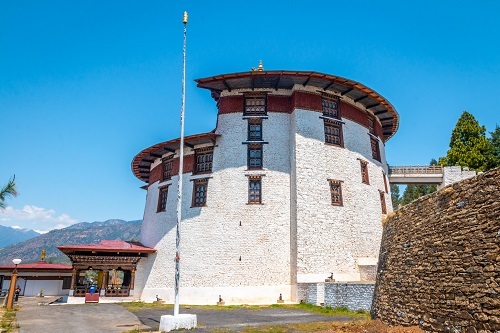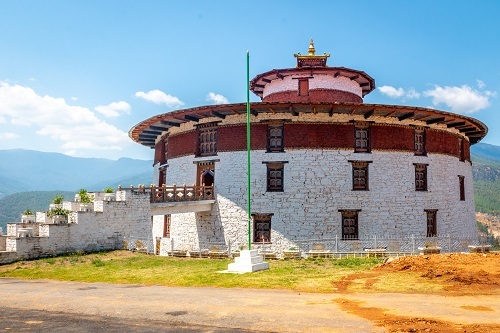Perched over Paro Rinpung Dzong is the Ta Dzong (watchtower) built in 1649 to protect the dzong. It was renovated in 1968 as the National Museum of Bhutan under the command of the third king, Jigme Dorji Wangchuck. It’s unusual round shape resembling a conch shell makes the museum highly attractive. The Ta Dzong is located on the river bank of Mangde Chu in Paro. There is an underground passage in Ta Dzong which is believed to connect the tower to Pa Chhu river and it was used to supply water during war time.

Notably, the museum structure had been uninhabited for an extended period especially when dzong state was weak and on the verge of collapse. However, during the reign of the third king, Jigme Dorji Wangchuck, the father of modern Bhutan, a complete renovation of the museum was ordered, and the structure was inhabited again. Like the other traditional structures in Bhutan, Ta Dzong was built with wood and stones without the use of a single nail. However, the Ta Dzong structure is stable and very strong as it has stood the test of time especially by surviving the 1714 and 1896 earthquakes.
Despite its sturdy foundation, the renovated parts of the tower could not stand the 2011 earthquake which had a magnitude of 6.9. The museum suffered extensive damage and about 3,000 antique artifacts had to be moved to a temporary hall in front of the main tower. Renovation of the museum began immediately after all the artifacts were relocated. The museum subsequently reopened in 2019.
Ta Dzong is the place for your induction of Bhutanese’s culture and traditions. National Museum of Bhutan houses some of the finest specimens of Bhutanese art, including masterpieces of bronze statues and paintings. The National Museum has in its possession over 3,000 Bhutanese art works, covering more than 1,500 years of Bhutan’s cultural heritage. It’s extensive collection of works makes it an ideal place for visitors to learn about the history, cultures and traditions of Bhutan.
There is also a documentary on the Bhutanese monarchy for visitors to gain deeper understanding of the revered royal family in Bhutan. The third floor is the royal gallery that showcases artefacts from the royal family. Some of the sacred items from the Wangchuck family include the First King’s robes, the Raven Crown, sword of Trongsa Penlop (governor) Jigme Namgyal, and Third King’s sword.

Other most revered treasures of the National Museum of Bhutan include a stone egg claimed to have been laid by a mule and a ritual dagger belonging to the protector Dorje Lekpa. There is also a section of stuffed animals, butterflies, handicrafts, jewelry, and textiles all from Bhutan. In the stamp section, there is an excellent display of triangular, embossed, silken, record, and 3-D stamps.
Considering that Buddhism is a widespread religion in Bhutan, this museum also houses fearsome festival masks and carvings of important teachers and saints from the region. Also, a few ancient iron links from the Tachhog iron bridge are housed in the museum.
Accessing the Museum
Access to the museum involves driving through a 4-kilometre loop into Dop Shari valley. While at the museum, one can easily access the town by walking down a path which passes through dzong. You can get excellent views of the valley and the Ugyen Pelri palace. If you are adventurous, you can also hike to the Zuri Dzong.
Ta Dzong museum is an important structure in Bhutan which houses thousands of historical artifacts. The museum stands on a landmark tower dating back to the 17th century which makes it an essential part of Bhutan's culture. Although there is no record of the initial architect of this historic tower, the impressive structure is still something to marvel at.
The Ta Dzong is open from Tuesday to Saturday from 9am to 4pm. Sunday is from 11am to 4pm. Ta Dzong is closed on Monday and some government holidays. Ta Dzong can be visited anytime within the operating hours.
